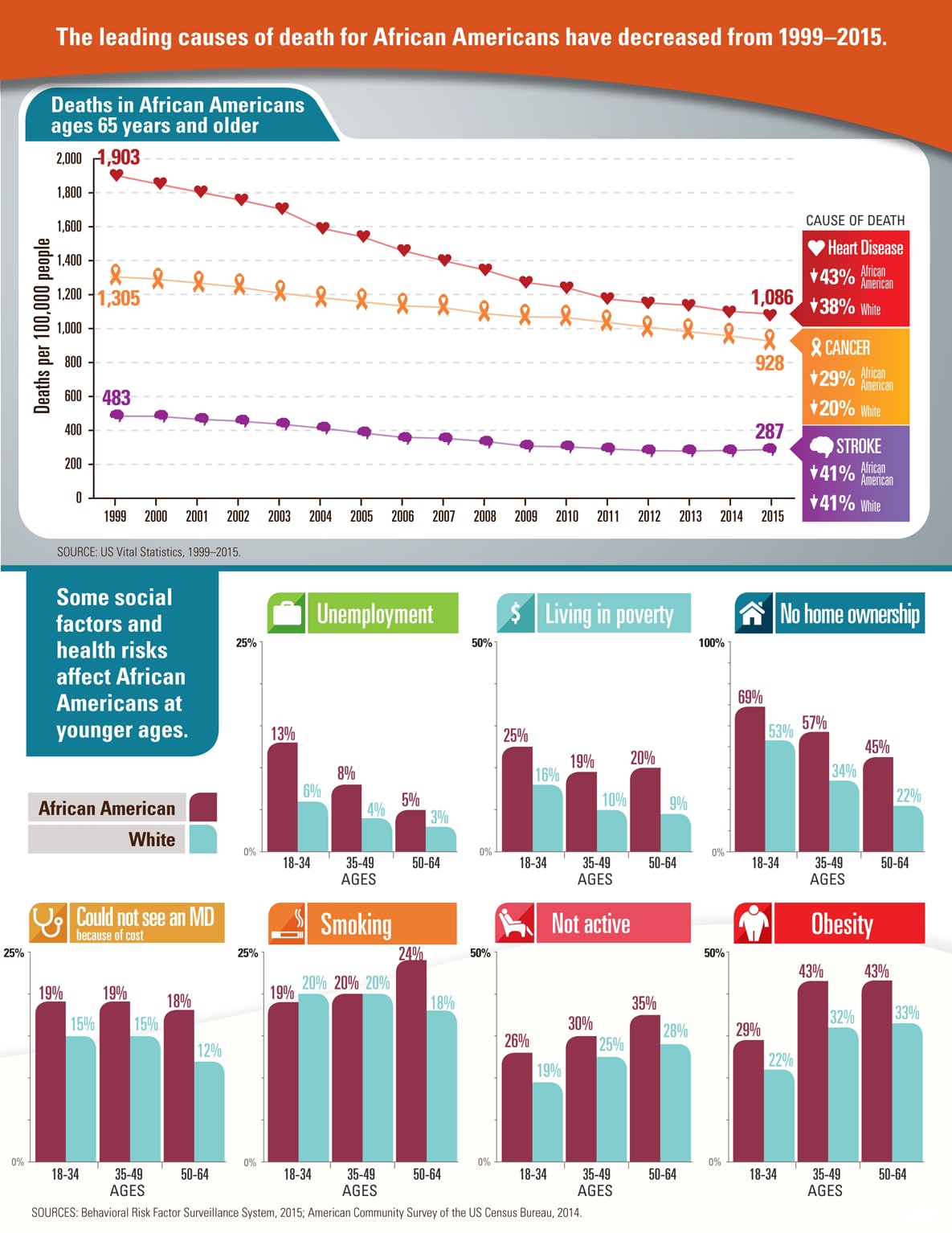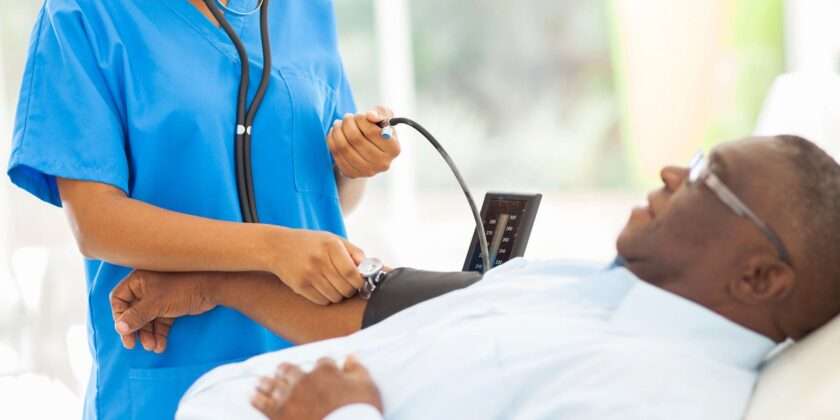“No matter how rich or poor you are, all life will come to an halt with two types of destinations; Heaven and Hell.” ― Callum Illman. It sure seems like the rich are trying to give the poor hell on earth. A determined effort is being made to destroy the health care safety net of Medicaid and Obamacare. The argument is made that you should pay your way. If that’s true, why are there tax breaks for business and wealthy individuals?
The good news is that Black Americans are taking actions to increase their life expectancy. Better diet, exercise and get better control of diseases such as high blood pressure, and diabetes has contributed to longer lives.
Jay Harold has used data from the Centers for Disease Control (CDC) to give a snap of the health of Black Americans from 1999 to 2015.
Minority Health Determines the Health of the Nation1 – The United States has become increasingly diverse in the last century. According to the 2010 U.S. Census, approximately 36 percent of the population belongs to a racial or ethnic minority group. Though health indicators such as life expectancy and infant mortality have improved for most Americans, some minorities experience a disproportionate burden of preventable disease, death, and disability compared with non-minorities.
African Americans are living longer. The death rate for African Americans has declined about 25% over 17 years2, primarily for those aged 65 years and older. Even with these improvements, a new analysis shows that younger African Americans are living with or dying from many conditions typically found in white Americans at older ages. The difference shows up in African Americans in their 20s, 30s, and 40s for diseases and causes of death. When diseases start early, they can lead to death earlier. Chronic diseases and some of their risk factors may be silent or not diagnosed during these early years. Health differences are often due to economic and social conditions that are more common among African Americans than whites. For example, African American adults are more likely to report they cannot see a doctor because of cost. All Americans should have equal opportunities to pursue a healthy lifestyle.
African American Health3

Problem: Young African Americans are living with diseases more common at older ages.
| Disease type | Ages | Race/Ethnicity | Percent (%) |
| High blood pressure | 18-34 | African American | 12 |
| White | 10 | ||
| 35-49 | African American | 33 | |
| White | 22 | ||
| 50-64 | African American | 64 | |
| White | 41 | ||
| Diabetes | 18-34 | African American | 1.5 |
| White | 1.4 | ||
| 35-49 | African American | 10 | |
| White | 6 | ||
| 50-64 | African American | 23 | |
| White | 14 | ||
| Stroke | 18-34 | African American | 0.7 |
| White | 0.4 | ||
| 35-49 | African American | 2 | |
| White | 1 | ||
| 50-64 | African American | 7 | |
| White | 4 |
African Americans and whites include Hispanic and non-Hispanic origin.
Source: Behavioral Risk Factor Surveillance System, 2015.

Heart Disease has dropped 43% among African Americans over the last 16 years.
Some social factors and health risks affect African Americans at younger ages:
| Social factor/health risk | Ages | Race/Ethnicity | Percent (%) |
| Unemployment | 18-34 | African American | 13 |
| White | 6 | ||
| 35-49 | African American | 8 | |
| White | 4 | ||
| 50-64 | African American | 5 | |
| White | 3 | ||
| Living in poverty | 18-34 | African American | 25 |
| White | 16 | ||
| 35-49 | African American | 19 | |
| White | 10 | ||
| 50-64 | African American | 20 | |
| White | 9 | ||
| No home ownership | 18-34 | African American | 69 |
| White | 53 | ||
| 35-49 | African American | 57 | |
| White | 34 | ||
| 50-64 | African American | 45 | |
| White | 22 | ||
| Could not see an MD because of cost | 18-34 | African American | 19 |
| White | 15 | ||
| 35-49 | African American | 19 | |
| White | 15 | ||
| 50-64 | African American | 18 | |
| White | 12 | ||
| Smoking | 18-34 | African American | 19 |
| White | 20 | ||
| 35-49 | African American | 20 | |
| White | 20 | ||
| 50-64 | African American | 24 | |
| White | 18 | ||
| Not active | 18-34 | African American | 26 |
| White | 19 | ||
| 35-49 | African American | 30 | |
| White | 25 | ||
| 50-64 | African American | 35 | |
| White | 28 | ||
| Obesity | 18-34 | African American | 29 |
| White | 22 | ||
| 35-49 | African American | 43 | |
| White | 32 | ||
| 50-64 | African American | 43 | |
| White | 33 |
SOURCES: Behavioral Risk Factor Surveillance System, 2015; American Community Survey of the US Census Bureau, 2014.
African Americans are more likely to die at early ages from all causes.
| Ages | Race/Ethnicity | Deaths per 100,000 people |
| 18-34 | African American | 142 |
| White | 100 | |
| 35-49 | African American | 312 |
| White | 220 | |
| 50-64 | African American | 1,046 |
| White | 722 |
State Variation in Health Care Service Utilization: United States4, 2014

African American adults are more likely to report they cannot see a doctor because of cost.
Key findings
Data from the National Health Interview Survey, 2014
- The percentage of adults without a usual place of medical care ranged from 2.8% in Vermont to 26.7% in Nevada.
- The percentage of adults who did not have a general doctor visit in the past 12 months ranged from 15.9% in Vermont to 48.1% in Montana.
- The percentage of adults without a usual place of medical care was lower in states that expanded Medicaid compared with nonexpansion states.
- The percentage of adults without a usual place of medical care or who did not see a general doctor in the past 12 months was lower in states with partnership marketplaces compared with Federally Facilitated Marketplace states.
Congress passed a billed to repeal Obamacare on May 3, 20175. Let’s hope that the replacement bill maintains or increases healthcare for all Americans.
Enjoyed this post? Share it and read more here. Jay Harold has put together a Resource page that you may find useful when trying to improve your health and wealth.Please take this advice of Muhammad Ali and give back to others. “Service to others is the rent you pay for your room here on earth.” ~ Muhammad Ali.




